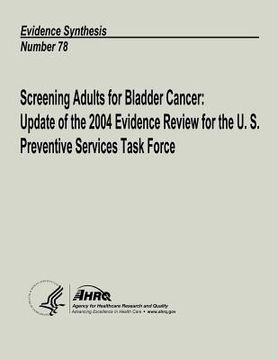Screening Adults for Bladder Cancer: Update of the 2004 Evidence Review for the U. S. Preventive Services Task Force: Evidence Synthesis Number 78 (in English)
Synopsis "Screening Adults for Bladder Cancer: Update of the 2004 Evidence Review for the U. S. Preventive Services Task Force: Evidence Synthesis Number 78 (in English)"
Bladder cancer is the fourth most commonly diagnosed cancer in men and the ninth most commonly diagnosed cancer in women in the United States. Screening could identify bladder cancer at earlier stages, when it may be more easily and effectively treated. The U.S. Preventive Services Task Force (USPSTF) last reviewed the evidence on bladder cancer screening in 2004. The USPSTF commissioned an update of the evidence review in 2009 in order to update its recommendation on screening. Bladder cancer remains an important public health problem, with no improvements in incidence or associated mortality since 1975. There is important uncertainty regarding bladder cancer screening, particularly in higher-risk patients. In addition, since the last USPSTF review, research on urinary biomarkers for diagnosis of bladder cancer has accumulated substantially. The purpose of this report is to systematically evaluate the current evidence on screening for bladder cancer. In the United States, over 90 percent of bladder cancers are transitional cell carcinomas, 5 percent are squamous cell carcinomas, and less than 2 percent are adenocarcinomas. Bladder cancer is typically staged according to the American Joint Committee on Cancer Tumor Node Metastases (TNM) criteria, in which the tumor stage (T) is based on the extent of penetration or invasion into the bladder wall and adjacent structures. Superficial bladder cancers, or those that have not invaded the bladder smooth muscle, include stages Ta (noninvasive papillary carcinoma), Tis (carcinoma in situ), and T1 (tumor has invaded the subepithelial connective tissue) tumors. Tumors stage 2 and higher are muscle invasive. The likelihood of progression to invasive cancer is associated with the presence of more poorly differentiated cells and other histopathologic features. According to a 1998 World Health Organization and International Society of Urological Pathology consensus statement, transitional cell carcinomas are classified histopathologically into one of four categories: papilloma, papillary urothelial neoplasm of low malignant potential, low grade carcinoma, and high grade carcinoma. The incidence of bladder cancer in the United States in 2005 was approximately 21 per 100,000 persons, or 0.02 percent. The American Cancer Society estimates that 70,980 new cases of bladder cancer will be diagnosed in the United States during 2009 (about 52,810 men and 18,170 women), and about 14,330 people will die of the disease (about 10,180 men and 4,150 women). By comparison, it is estimated that there will be 219,440 new cases of lung cancer and 159,390 deaths (88,900 in men and 70,490 in women), 146,970 new cases of colorectal cancer and 49,920 deaths (25,240 in men and 24,680 in women), 42,470 new cases of pancreatic cancer and 35,240 deaths (18,030 in men and 17,210 in women), 192,280 new cases of prostate cancer and 27,360 prostate cancer deaths, 192,370 new cases of breast cancer and 40,170 breast cancer deaths, 42,160 new cases of uterine cancer and 7,780 uterine cancer deaths, and 11,270 new cases of cervical cancer and 4,070 cervical cancer deaths. Bladder cancer occurs primarily in men older than 60 years of age and roughly twice as frequently in white compared to black men. The Key Questions used to guide this evidence synthesis are: 1. Is there direct evidence that screening for bladder cancer reduces morbidity or mortality? 2. What are the accuracy and reliability of urinalysis for hematuria, urine cytology, and urine biomarkers for identification of bladder cancer? 3. Does treatment of screen-detected bladder cancer reduce morbidity and mortality from this disease? 4. What are the harms of screening for bladder cancer and treatment of screen-detected bladder cancer?

